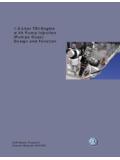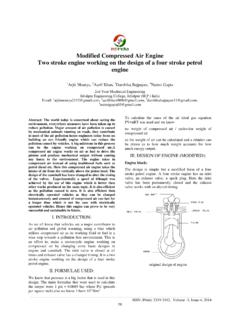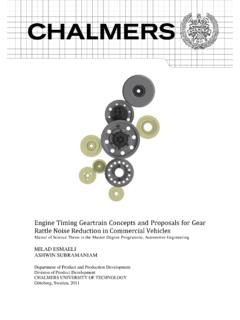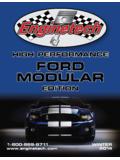Transcription of 1.9-Liter TDI Engine with Pump Injection
1 TDI Enginewith Pump Injection (Pumpe D se)Design and FunctionSelf-Study ProgramCourse Number 841303 Volkswagen of America, TrainingPrinted in 10/2003 Course Number 841303 2003 Volkswagen of America, rights reserved. All information containedin this manual is based on the latestinformation available at the time of printingand is subject to the copyright and otherintellectual property rights of Volkswagen ofAmerica, Inc., its affiliated companies and itslicensors. All rights are reserved to makechanges at any time without notice. No partof this document may be reproduced,stored in a retrieval system, or transmittedin any form or by any means, electronic,mechanical, photocopying, recording orotherwise, nor may these materials bemodified or reposted to other sites withoutthe prior expressed written permission ofthe requests for permission to copy andredistribute information should be referredto Volkswagen of America, check Technical Bulletins and theVolkswagen Worldwide Repair InformationSystem for information that may supersedeany information included in this : All brand names and productnames used in this manual are trade names,service marks, trademarks, or registeredtrademarks; and are the property of theirrespective of ContentsThe Self-Study Program provides you with informationregarding designs and Self-Study Program is not a Repair maintenance and repair work, always refer to thecurrent technical !
2 New!Introduction .. TDI Engine with Pump Injection SystemEngine Mechanics .. 2 Development of the TDI Engine with PumpInjection System, Technical Data TDI Enginewith Pump Injection System, Trapezoidal Piston andConnecting Rod, Toothed Belt DriveFuel Supply .. 8 Fuel Supply System Overview, Fuel Pump,Distributor Pipe, Fuel Cooling SystemPump Injection System .. 15 Pump/Injectors, Design, Injection CycleEngine Management .. TDI Engine EDC 16 System Overview,Sensors, ActuatorsGlow Plug System .. 53 Glow Plug SystemFunctional Diagram .. 54 EDC 16 Functional Diagram for TDI EngineService .. 56 Self-Diagnosis, Pump/Injector Adjustment, Special ToolsKnowledge Assessment .. TDI Engine withPump Injection SystemThe demands on the modern diesel enginefor increased performance and fueleconomy, and reduced exhaust emissionsand noise levels are growing fuel and air mixture preparation is akey factor in meeting these calls for efficient Injection systems thatproduce high Injection pressures to ensurethat the fuel is well atomized.
3 It is alsonecessary to precisely control the start offuel Injection and the Injection pump Injection system meetsthese 1905, Rudolf Diesel came up with theidea of a pump/injector, combining theinjection pump and injector in one unitin order to dispense with high-pressurelines and achieve high Injection the time, however, he did not havethe technical means to put his ideainto engines with mechanically controlledpump Injection systems have been in usein ships and trucks since the association with Bosch, Volkswagen hassucceeded in developing a diesel enginewith a solenoid valve controlled pumpinjection system suitable for use inpassenger TDI Engine with the new pumpinjection system meets the stringentdemands for improved performance andcleaner continuing advances like this one,Rudolf Diesel s vision of smoke- andodor-free exhaust gases may one daybecome a Mechanics2 Development of TDI Engine withPump Injection SystemThe new 100 bhp (74 kW) TDIengine with pump Injection system wasdeveloped from the existing 109 bhp (81kW) TDI Engine with a distributorinjection pump and no intermediate pump Injection system comprises theonly significant difference between thetwo Self-Study Program concernsthe design and function of the new pumpinjection system, and the modificationsto the fuel system, Engine managementsystem, and Engine mechanicalcomponents to accommodate the diesel Engine with the pump injectionsystem has the following advantages overan Engine with a distributor Injection pump: Low combustion noise.
4 Low fuel consumption. Clean emissions. High advantages are attributable to: The high Injection pressures of up to27,846 psi (192,000 kPa / 1,920 bar). Precise control of the Injection cycle. The pre- Injection (rpm)3 Engine MechanicsTechnical Data TDI Engine withPump Injection System Engine codeBEW TypeFour-cylinder in-line Engine with twovalves per cylinder cu in (1,896 cm3) in ( mm) in ( mm) Compression : 1 Maximum power output100 bhp (74 kW) @ 4000 rpm Maximum torque177 lbs-ft (240 Nm) @ 1800 to 2400 rpm Engine managementEDC 16 Firing sequence1-3-4-2 Emission ControlBin 10 EPA Federal Emissions Concept,OBD II, catalytic converter, water-cooledEGR systemSSP209/006 TorqueOutput10002000300040005000lbs-ft Nm221 300184 250148 200111 15074 10037500hp kW1219010175806060454030201504 Engine MechanicsTrapezoidal Pistonand Connecting RodTo accommodate the higher combustionpressures in the TDI Engine withpump Injection system than areencountered in the base Engine , the pistonhub and the connecting rod eye aretrapezoidal in MechanicsThis distributes the combustion forces overa larger area and relieves the load on thepiston pin and connecting comparison with the conventionalparallelogram-shaped link between thepiston and connecting rod.
5 The trapezoidalconnecting rod eye and piston hub have alarger contact surface area at the piston pinowing to their ForceContact SurfaceForce Distribution in a Parallelogram-ShapedPiston and Connecting RodForce Distribution in a Trapezoidal Pistonand Connecting RodCombustion ForceContact SurfaceSSP209/009 Toothed Belt DriveHigh pump forces are required to generatehigh Injection pressures of up to 27,846 psi(192,000 kPa / 1,920 bar).These forces subject the components ofthe toothed belt drive to high relieve the load on the toothed belt,several modifications have been made. A vibration absorber integrated in thecamshaft gear reduces vibration inthe toothed belt drive. The toothed belt is about inch(5 mm) wider than the toothed belt usedin the base Engine . Higher forces can betransmitted by the larger surface area. A hydraulic tensioner keeps thetoothed belt evenly tensioned indifferent load states. Some of the teeth on the crankshafttiming belt gear have a larger gapclearance to reduce toothed belt relieve the load on the toothed beltduring the Injection cycle, the crankshafttiming belt gear has two pairs of teeth witha larger gap clearance than the other MechanicsFunctionDuring the Injection cycle, the highpumping forces exert a heavy load on thetoothed camshaft timing belt gear is sloweddown by the pumping forces.
6 At the sametime, the combustion process speeds upthe crankshaft timing belt gear. The toothedbelt is stretched and the pitch is temporarilyincreased as a of the Engine firing order, thisstretching process occurs at regularintervals and the same teeth on the timingbelt gear are in mesh with the toothed beltevery tooth gap clearanceOn the TDI Engine with pumpinjection system, the crankshaft timing beltgear teeth have a larger gap clearance atthese points to compensate for the changein belt tooth pitch and thus reduce toothedbelt ForceAcceleration ForcePitchEngine Mechanics8 Fuel SupplyFuel Supply System OverviewA mechanical fuel pump sucks the fuel outof the fuel tank through the fuel filter andpumps it along the supply line in thecylinder head to the Cooler Cools the returning fuelto prevent excessively hot fuel frombeing routed back to the fuel fuel that is not required for Injection isreturned to the fuel tank via the return linein the cylinder head, a fuel temperaturesensor.
7 And a fuel Valve Prevents fuelfrom the fuel pump flowing back intothe fuel tank while the Engine is notrunning. It has an opening pressureof psi (20 kPa / bar).Fuel Filter Protects the injectionsystem against contamination andwear caused by particles and Temperature Sensor G81 Determines the temperature of thefuel in the fuel return line and sends acorresponding signal to the Diesel DirectFuel Injection Engine Control Module Tank9 Fuel SupplySSP209/018 Fuel Return Line PressureLimiting Valve Keeps thepressure in the fuel return lineat psi (100 kPa / 1 bar).This maintains a forceequilibrium at the pump/injector solenoid valve Collects vapor bubbles in thefuel supply line. These vapor bubbles arethen separated through the restrictorinto the return Supply Line Pressure Limiting Valve Regulates the fuel pressure in the fuel supply valve opens when the fuel pressure exceeds109 psi (750 kPa / bar). Fuel is routed back tothe suction side of the fuel Pump Rotor Pumps the fuel fromthe fuel tank through the fuel filter andthe fuel supply line in the cylinder headto the Located between thefuel supply line and the fuel returnline.
8 Vapor bubbles in the fuel supplyline are separated through therestrictor into the fuel return Limiting Valve Bypass If there is air in the fuel system,for example when the fuel tankis empty, the pressure limitingvalve remains closed. The air isexpelled from the system by thefuel flowing into the HeadThere is a fitting on the fuelpump for connecting pressuregauge VAS 5187 to check thefuel pressure in the supply refer to the Repair Manualfor Supply10 Fuel PumpThe fuel pump is located directly behindthe vacuum pump at the cylinder moves the fuel from the fuel tank to pumps are driven jointly by thecamshaft. They are collectively known asa tandem Return LineSSP209/049 Pressure GaugeConnection FittingFuel PumpVacuum PumpFuel Supply Line11 Fuel SupplyThe fuel pump is a blocking vane-cell blocking vanes are pressed against thepump rotor by spring pressure. This designenables the fuel pump to deliver fuel evenat low Engine fuel ducting system within the pumpis designed so that the rotor alwaysremains wetted with fuel, even if the tankhas been run dry.
9 This makes automaticpriming VanesRestrictorConnection forFuel Supply LineFuel Supply LinePressure Limiting ValveTo Fuel Supply Linein Cylinder HeadStrainerConnection forFuel Return LineFuel ReturnLine PressureLimiting ValveRotorFrom FuelReturn Line inCylinder Head12 FunctionThe fuel pump operates by taking fuel in asthe pump chamber volume increases andpushing the fuel out under pressure as thechamber volume is fuel is drawn into two chambers andpumped out from two chambers. Theintake and delivery chambers are separatedfrom one another by the spring-loadedblocking vanes and the pump rotor drawn into chamber 1 is pushed out atchamber 2. Fuel drawn into chamber 3 ispushed out at chamber rotation of the rotor increases thevolume of chamber 1 while the volume ofchamber 4 is simultaneously is pushed out of chamber 4 to thefuel supply line in the cylinder SupplyThe rotation of the rotor increases thevolume in chamber 3 as it reduces thevolume in chamber 2. Fuel drawn in atchamber 1 is forced out of chamber 2 tothe fuel supply line in the cylinder 4 Chamber 3 Chamber 2 Chamber 1 SSP209/051 Chamber 1 RotorChamber 4 Chamber 3 Chamber 213 Fuel SupplyDistributor PipeA distributor pipe is integrated in the fuelsupply line in the cylinder head.
10 It distributesthe fuel evenly to the pump/injectors at auniform the supply line, the fuel moves throughthe center of the distributor pipe towardcylinder 1 at the far fuel also moves through the crossholes in the distributor pipe and enters theannular gap between the distributor pipeand the cylinder head fuel mixes with the hot unused fuelthat has been forced back into the supplyline by the results in a uniform temperatureof the fuel in the supply line running toall pump/injectors are supplied withthe same fuel mass, and the engineruns HeadAnnular GapCross HolesCylinder 4 Cylinder 3 Cylinder 2 Cylinder 1 Distributor PipeSSP209/040 SSP209/29 Cross HolesMixing Fuel inAnnular GapFuel to Pump/InjectorFuel fromPump/Injector14 Fuel SupplyFuel Cooling CircuitThe heated fuel returning from the pump/injectors flows through the fuel cooler andits heat transfers to the coolant in the fuelcooling circuit that also flows through thefuel auxiliary water cooler reduces thetemperature of the coolant in the fuelcooling circuit by dissipating the heat inthe coolant to the ambient for Fuel Cooler V166 is an electricrecirculation pump.










